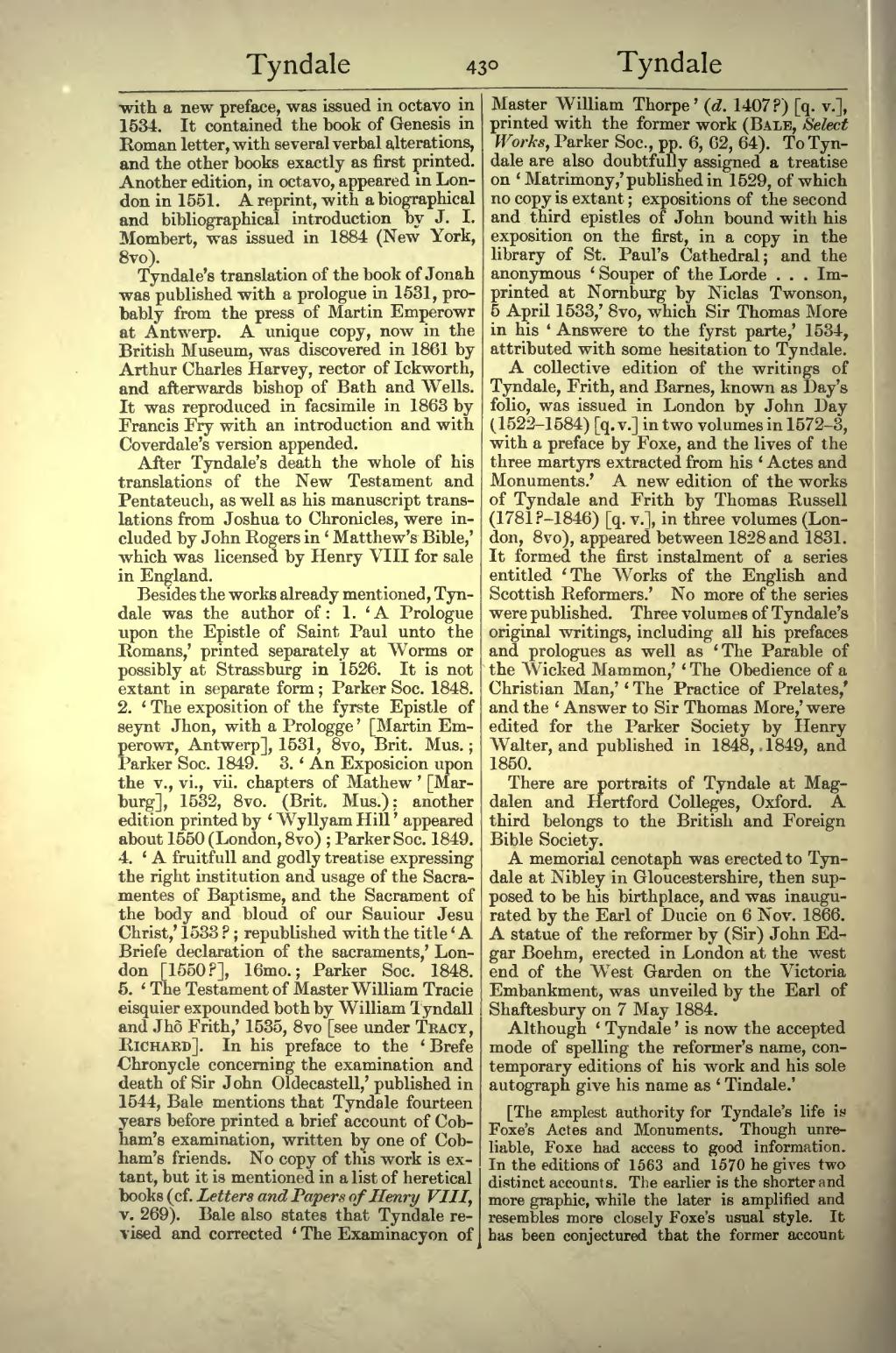with a new preface, was issued in octavo in 1534. It contained the book of Genesis in Roman letter, with several verbal alterations, and the other books exactly as first printed. Another edition, in octavo, appeared in London in 1551. A reprint, with a biographical and bibliographical introduction by J. I. Mombert, was issued in 1884 (New York, 8vo).
Tyndale's translation of the book of Jonah was published with a prologue in 1531, probably from the press of Martin Emperowr at Antwerp. A unique copy, now in the British Museum, was discovered in 1861 by Arthur Charles Harvey, rector of Ickworth, and afterwards bishop of Bath and Wells. It was reproduced in facsimile in 1863 by Francis Fry with an introduction and with Coverdale's version appended.
After Tyndale's death the whole of his translations of the New Testament and Pentateuch, as well as his manuscript translations from Joshua to Chronicles, were included by John Rogers in ‘Matthew's Bible,’ which was licensed by Henry VIII for sale in England.
Besides the works already mentioned, Tyndale was the author of:
- ‘A Prologue upon the Epistle of Saint Paul unto the Romans,’ printed separately at Worms or possibly at Strassburg in 1526. It is not extant in separate form; Parker Soc. 1848.
- ‘The exposition of the fyrste Epistle of seynt Jhon, with a Prologge’ [Martin Emperowr, Antwerp], 1531, 8vo, Brit. Mus.; Parker Soc. 1849.
- ‘An Exposicion upon the v., vi., vii. chapters of Mathew’ [Marburg], 1532, 8vo. (Brit. Mus.); another edition printed by ‘Wyllyam Hill’ appeared about 1550 (London, 8vo); Parker Soc. 1849.
- ‘A fruitfull and godly treatise expressing the right institution and usage of the Sacramentes of Baptisme, and the Sacrament of the body and bloud of our Sauiour Jesu Christ,’ 1533?; republished with the title ‘A Briefe declaration of the sacraments,’ London [1550?], 16mo.; Parker Soc. 1848.
- ‘The Testament of Master William Tracie eisquier expounded both by William Tyndall and Jhõ Frith,’ 1535, 8vo [see under Tracy, Richard].
In his preface to the ‘Brefe Chronycle concerning the examination and death of Sir John Oldecastell,’ published in 1544, Bale mentions that Tyndale fourteen years before printed a brief account of Cobham's examination, written by one of Cobham's friends. No copy of this work is extant, but it is mentioned in a list of heretical books (cf. Letters and Papers of Henry VIII, v. 269). Bale also states that Tyndale revised and corrected ‘The Examinacyon of Master William Thorpe’ (d. 1407?) [q. v.], printed with the former work (Bale, Select Works, Parker Soc., pp. 6, 62, 64). To Tyndale are also doubtfully assigned a treatise on ‘Matrimony,’ published in 1529, of which no copy is extant; expositions of the second and third epistles of John bound with his exposition on the first, in a copy in the library of St. Paul's Cathedral; and the anonymous ‘Souper of the Lorde … Imprinted at Nornburg by Niclas Twonson, 5 April 1533,’ 8vo, which Sir Thomas More in his ‘Answere to the fyrst parte,’ 1534, attributed with some hesitation to Tyndale.
A collective edition of the writings of Tyndale, Frith, and Barnes, known as Day's folio, was issued in London by John Day (1522–1584) [q. v.] in two volumes in 1572–3, with a preface by Foxe, and the lives of the three martyrs extracted from his ‘Actes and Monuments.’ A new edition of the works of Tyndale and Frith by Thomas Russell (1781?–1846) [q. v.], in three volumes (London, 8vo), appeared between 1828 and 1831. It formed the first instalment of a series entitled ‘The Works of the English and Scottish Reformers.’ No more of the series were published. Three volumes of Tyndale's original writings, including all his prefaces and prologues as well as ‘The Parable of the Wicked Mammon,’ ‘The Obedience of a Christian Man,’ ‘The Practice of Prelates,’ and the ‘Answer to Sir Thomas More,’ were edited for the Parker Society by Henry Walter, and published in 1848, 1849, and 1850.
There are portraits of Tyndale at Magdalen and Hertford Colleges, Oxford. A third belongs to the British and Foreign Bible Society.
A memorial cenotaph was erected to Tyndale at Nibley in Gloucestershire, then supposed to be his birthplace, and was inaugurated by the Earl of Ducie on 6 Nov. 1866. A statue of the reformer by (Sir) John Edgar Boehm, erected in London at the west end of the West Garden on the Victoria Embankment, was unveiled by the Earl of Shaftesbury on 7 May 1884.
Although ‘Tyndale’ is now the accepted mode of spelling the reformer's name, contemporary editions of his work and his sole autograph give his name as ‘Tindale.’
